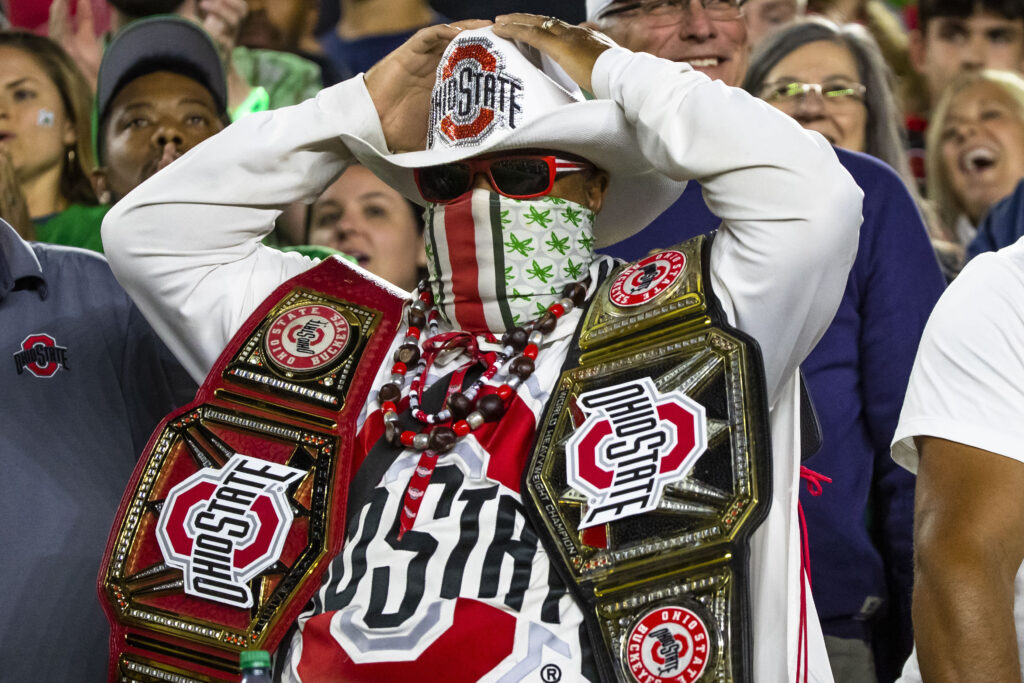The Hotline mailbag publishes each Friday. Send questions to pac12hotline@bayareanewsgroup.com and include ‘mailbag’ in the subject line. Or hit me on Twitter: @WilnerHotline.
Please note: Some questions have been edited for clarity and brevity.
Which of the Big Ten matchups on the four West Coast campuses are you most excited to see in 2024? — @DouglasTS
There are three options and no wrong answers.
The Big Ten used an incredibly complex scheduling model that produced 261 unsatisfactory options for the 2024-28 opponent rotation, but the 262nd version hit the mark.
The process included breaking the 18 schools into two groups of nine, three groups of six and six groups of three — all to create balance within each bucket.
We couldn’t help but note that Oregon has nine games against the Big Ten’s Big Three (Ohio State, Michigan and Penn State) over the five-year timeframe. The Trojans and Huskies have eight, but UCLA has just seven.
Is that a sign the Bruins were placed in a different (lower) bucket than the other three? Perhaps. The Big Ten would have been justified in doing so: UCLA’s on-field success over the years cannot match that of the Trojans, Ducks and Huskies.
This much is certain: UCLA was handed a far less intriguing home schedule for the 2024 season with regard to the existing Big Ten schools: Indiana, Iowa and Minnesota are visiting the Rose Bowl. Those aren’t exactly must-see opponents for UCLA fans (although the visitors will undoubtedly draw well in Pasadena).
On the other hand, we have these marquee games on the other three West Coast campuses:
— Ohio State at Oregon
— Penn State at USC
— Michigan at Washington
Each carries multiple layers of intrigue, but if we had to pick one, it would be the showdown in Seattle.
Why? Because we were supposed to see the Wolverines in Husky Stadium at the start of the 2020 season, but COVID had other ideas and the game was rescheduled for Sept. 9, 2028.
And guess what? The Big Ten’s schedule took that into account: The Wolverines will visit Washington in 2028, although probably not in September.
(The order and dates of the Big Ten’s 2024 schedule probably will be released in November or December.)
Some Hotline readers might recall that Michigan’s trip to Seattle in September 2020 wasn’t the only showdown scheduled for the Pacific Northwest that month. Ohio State was supposed to visit Autzen Stadium one week later but that, too, was derailed by COVID.
The Ducks and Buckeyes later announced a home-and-home series for 2032-33, and that series could stick on a future Big Ten schedule. But between now and then, the teams will meet at least three times: The Buckeyes are in Eugene in 2024 and 2027, while Oregon heads to Columbus in 2026.
Granted, any appearance by Ohio State constitutes an A+ spectacle, so we would slot the OSU-Oregon clash just behind the Michigan-Washington affair.
But USC-Penn State is a premier matchup, in part because of the rematch component: The schools played one of the greatest Rose Bowls in history, with the Trojans surviving 52-49 in Jan. 2017.
Again, there is no wrong answer. All three collisions will be must-watch television, which is why Fox and friends decided to plow more than $1 billion annually into the Big Ten’s media rights.
The new, restructured Big Ten schedule came out Thursday, and Washington’s travel has almost tripled from this year. How do the Huskies afford this on the halved revenue until the next media rights deal in 2030? — @Cargoman0363
Ask Ana Mari Cauce.
Washington’s president signed off on the Big Ten move knowing that her athletic department would receive half-shares (approximately) of the media rights revenue — or about $32.5 million, on average, through the 2030 fiscal year.
She also approved the move knowing how much travel would be involved in the move.
And knowing the cost of charter flights is rising.
And knowing UW’s football program must be funded at levels that allow the Huskies to compete for the Big Ten title and College Football Playoff berths.
Otherwise, Washington might as well be Maryland — a coastal school that’s just happy to be a member of the Chicago-based conference but has little chance to make an impact in the sport that matters most.
Is it historically more difficult for East Coast teams to play in the Pacific Time Zone than for West Coast teams to play in the Eastern Time Zone? Follow up: Did USC torpedo the Big Ten’s West Coast quartet being protected matchups? — @keithdennis
To address the second question first: I have no knowledge of that situation. None whatsoever.
However, Big Ten executives were extremely convincing Thursday when they explained that greater scheduling immersion for new members helps facilitate conference cohesion. The more the West Coast schools play the likes of Purdue and Illinois and Iowa, the better.
We suspect the decision to limit the protected West Coast matchups to USC-UCLA and Oregon-Washington emanated from the conference office.
As for the impact of travel on performance, our unscientific view is the following: It depends on the kickoff time.
Nothing is more difficult than West Coast schools playing at 12 p.m. in the Eastern Time Zone.
But late games on the West Coast (7:30 p.m. kickoffs locally) aren’t necessarily easy for teams from the Eastern Time Zone. The players are up early because of the body clock disruption and have to wait 15 or more hours to take the field.
Can Oregon State and Washington State really wait things out for legal action against the outgoing schools? If so, how much do they realistically stand to claim? If not, how do you see it playing out money-wise for all involved via a negotiated settlement? — @jjfuller72
They can wait a few more months and are hoping that’s all the situation requires.
A hearing on the preliminary injunction is scheduled for Nov. 14 in Whitman County (Washington) Superior Court. The two sides could settle before then, of course. But if clarity comes in November, there’s probably enough time for the Cougars and Beavers to make whatever moves are required.
If the dispute goes to trial, which assuredly would stretch into 2024, then the timing gets tricky because of all the issues that must be resolved over and above the name and makeup of their conference.
The two schools need schedules for 2024; they need a media contract for 2024; they need clarity on NCAA governance matters for 2024. And the Mountain West needs answers, too.
There are 14 schools, not two, waiting for the Pac-12 to provide the needed documents and for the legal process to unfold.
We don’t have enough information to make an informed guess on the assets and liabilities other than the NCAA Tournament units, which translate to more than $60 million over the six-year payout period starting in the spring of 2025.
The Hotline will have estimates on the finances as soon as there’s clarity on the structure of the conference and the assets and liabilities. It’s simply too early to know, even though it’s starting to get a bit late.
Why didn’t ESPN pick up Washington State-UCLA this weekend? (It’s on the Pac-12 Networks.) — @Jmadden509
Because ESPN will take ninth-ranked, unbeaten USC (with Lincoln Riley and Caleb Williams) over unranked, one-loss UCLA any day of the week and 15 times on Saturday.
Yes, Washington State is a more attractive opponent than Arizona and traditionally generates larger audience numbers than the Wildcats.
But the difference between WSU and Arizona isn’t nearly as great as the difference between USC and UCLA under the current circumstances.
There are no FBS or FCS games inside California in Week 7. Is this unusual, or does it happen most years? — @CurtisBlack
I cannot state with any degree of certainty how often this happens, but it’s just a quirk of the schedule.
There is no collective effort by the schools or the conferences to put everyone on the road in a given week.
What are the voting margins required for College Football Playoff changes by the board of managers? I keep hearing decisions must be unanimous, but that seems odd. Are the votes required for changes different for the 2024/25 editions of the CFP than in 2026? — @AmbitiousCoug
All major issues, including revenue sharing, require unanimous approval by the College Football Playoff’s Board of Managers. (The Pac-12’s representative is Washington State president Kirk Schulz.)
However, the CFP contract with ESPN expires after the 2025 season, so the slate is blank for 2026 and beyond. If the SEC and Big Ten felt the need, they could create their own playoff and partner with ESPN or Fox, leaving everyone else behind.
My advice to WSU and OSU fans is to assume the playoff will rewrite the revenue sharing policy and the format, with an eye on diminishing the role of the reconfigured conference that houses the Cougars and Beavers.
However, it’s safe to assume that an automatic bid will be reserved for the top-ranked team from outside the power conferences.
Put another way: In a Power Four world, there will be five AQ spots and seven at-large berths.
If WSU or OSU wins either the Mountain West or the rebuilt Pac-12, it will have an excellent chance to qualify for the playoff.
What are your coverage plans for next year? — @stanley07
Will next year’s “Everything But The SEC Hotline” feature weekly Fantasy-Pac-12 Power Ratings? — @RajaMuh16021485
Appreciate the questions and good line. The “ACC/Big Ten/Big 12/Pac-2” Hotline will continue to report on the issues that impact the schools, regardless of their conference affiliation.
As an example, I would point readers to Thursday’s content. Not only did we report on the Big Ten’s schedule format for 2024-28, with a focus on the marquee matchups for the four West Coast schools, but we dove into a strategic matter with the Big Ten’s COO, Kerry Kenny:
Should the conference consider playing non-conference games in November to mirror the SEC’s late-season cupcake offering?
In our view, the additions of the four West Coast schools, combined with the Big Ten’s nine-game league lineup, will merely exacerbate the disparity in schedule difficulty with the SEC, which plays eight league games. And that could have an impact on CFP access, seeding and success.
One option for mitigating the SEC’s advantage: slide a non-conference game, or a bye week, into the Big Ten’s late-season schedule.
We will be covering the ACC, Big 12 and Pac-12/MW in exactly the same fashion.
The only thing changing on the Hotline is the quantity: More issues, more markets, more readers, more content.
*** Send suggestions, comments and tips (confidentiality guaranteed) to pac12hotline@bayareanewsgroup.com or call 408-920-5716
*** Follow me on Twitter: @WilnerHotline
*** Pac-12 Hotline is not endorsed or sponsored by the Pac-12 Conference, and the views expressed herein do not necessarily reflect the views of the Conference.
Related posts:
 Wilner Hotline: Sunday Reactions to Pac-12 Saturday, Devilish Downturn
Wilner Hotline: Sunday Reactions to Pac-12 Saturday, Devilish Downturn

UCLA guard Jaime Jaquez Jr. (24)(AP Photo/José Luis Villegas)
A quiet NBA Draft awaits the Pac-12, which speaks volumes about the state of the conference Pac-12 survival: Time for commissioner George Kliavkoff and the presidents to take swift, bold action (i.e., the “Costanza plan”)
Pac-12 survival: Time for commissioner George Kliavkoff and the presidents to take swift, bold action (i.e., the “Costanza plan”)

(AP Photo/Amanda Loman)
Pac-12 survival: Are Oregon, UW, Stanford and Cal worth the investment? Breaking down the Big Ten expansion mathJon Wilner
Jon Wilner has been covering college sports for decades and is an AP top-25 football and basketball voter as well as a Heisman Trophy voter. He was named Beat Writer of the Year in 2013 by the Football Writers Association of America for his coverage of the Pac-12, won first place for feature writing in 2016 in the Associated Press Sports Editors writing contest and is a five-time APSE honoree.
